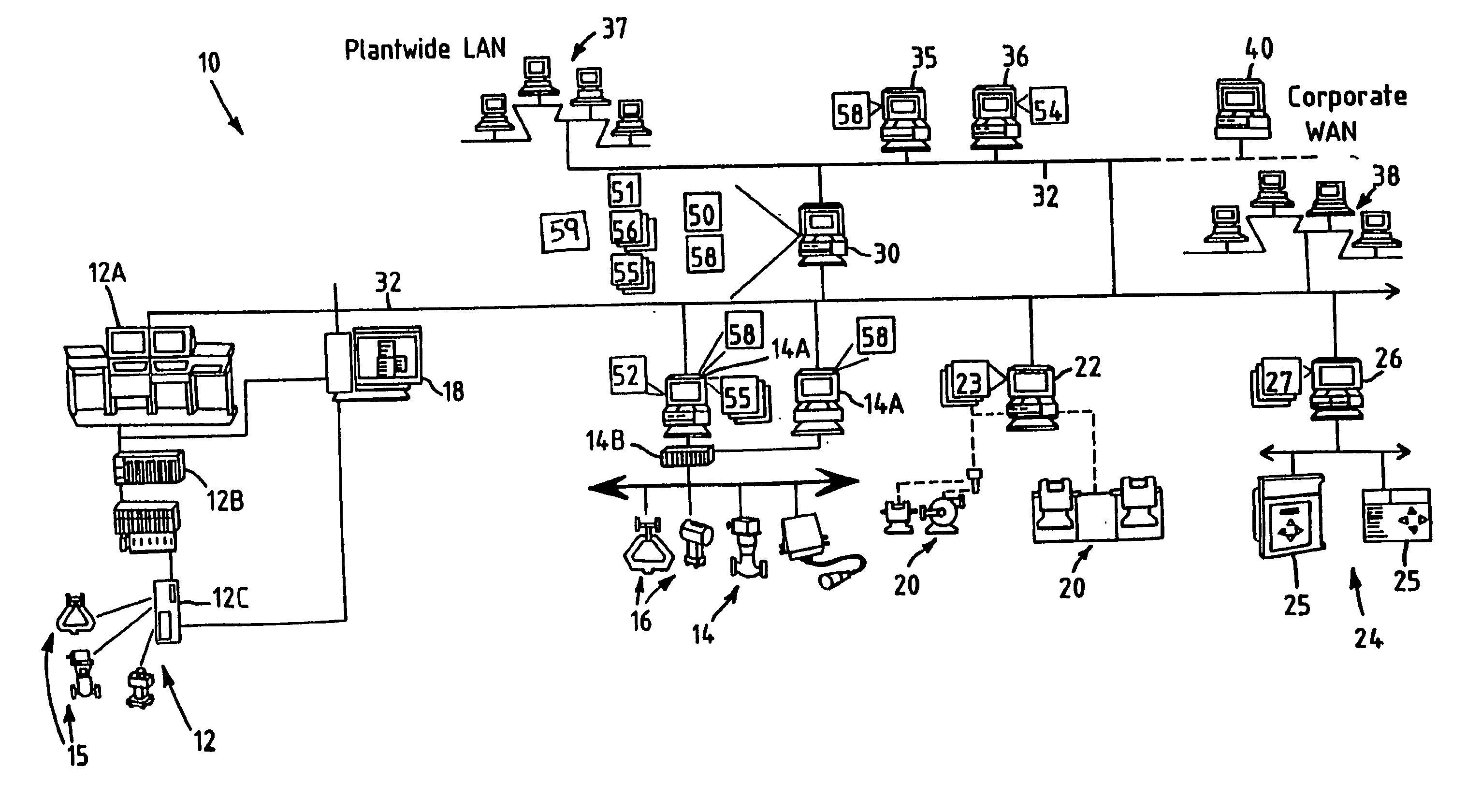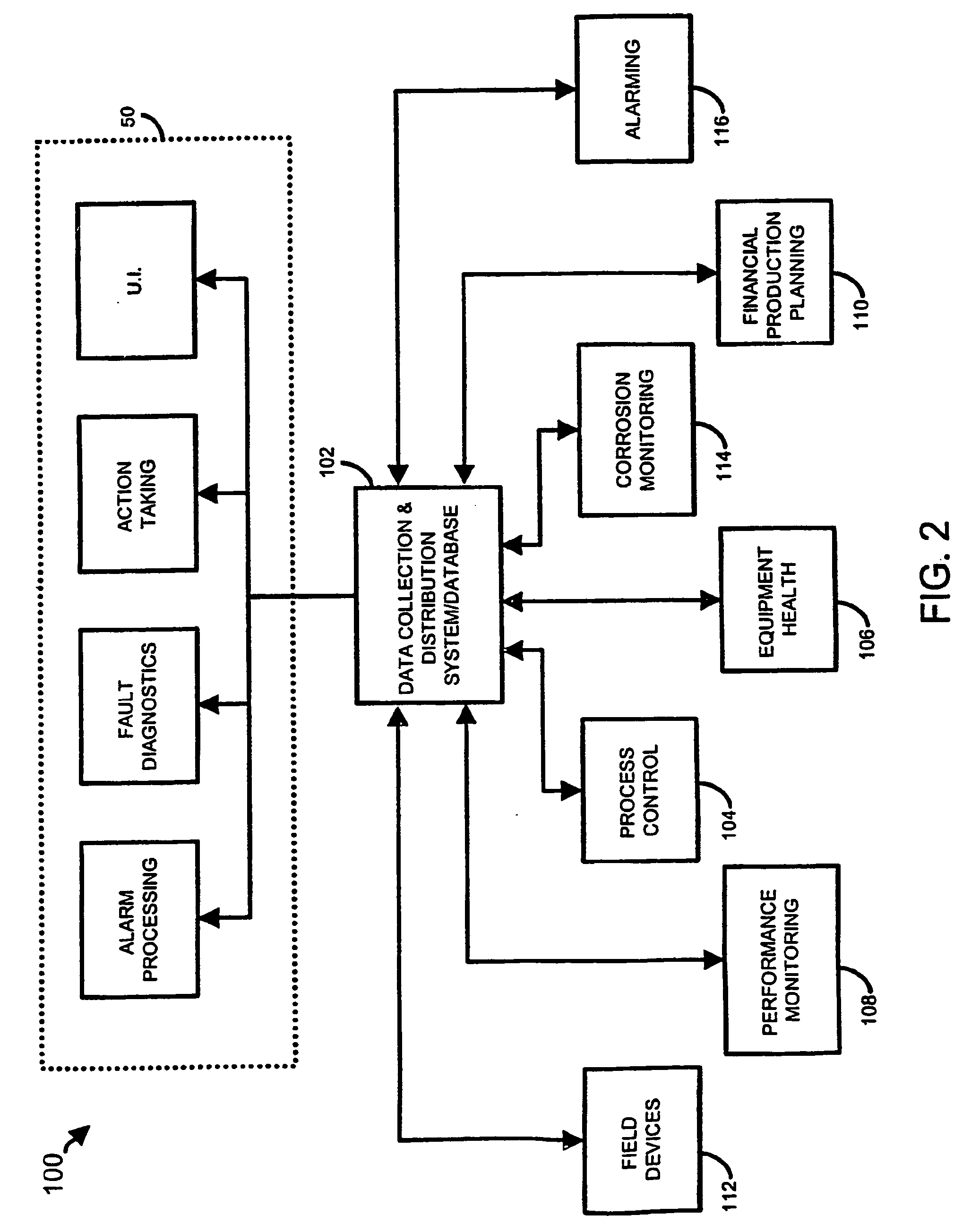However, these 4-20 mA signals are limited in nature because they are only indicative of process measurements made by the device or of
process control signals generated by the controller required to control the operation of the device during runtime.
As a result, conventional 4-20 mA devices are incapable of generating alarms or alerts pertaining to the operational capability or status of the devices.
Thus, alarms associated with the condition or status of these devices have generally not been available within
process control systems.
In
Fieldbus devices the subcode field is device and manufacturer specific so that different types of failures within a particular block of a given
Fieldbus device may result in different subcode field values and so that identical types of failures within different devices and / or within similar devices made by different manufacturers may also result in different subcode field values being sent within an
alarm message.
Unfortunately, the sixteen predefined Fieldbus alarm or alert conditions are grouped together under the BLOCK_ERR parameter and any one active condition (i.e., an alert or alarm condition that has been detected by the device) will cause the BLOCK_ALM parameter to report that the device has an active alarm or alert.
As a result, a relatively low priority alarm or alert condition may
mask the reporting of a more serious condition until the
system user or operator clears or acknowledges the first reported,
lower priority condition.
However, the BLOCK_ALM parameter will not be able to report the more serious “device needs maintenance now” condition until the alarm or alert reported in connection with the “device needs maintenance soon” condition is cleared or otherwise acknowledged by the
system user.
Unfortunately, the eight standard status conditions defined by the HART protocol and provided by HART compatible devices are typically not consistent with the status conditions provided by Fieldbus compatible devices.
As a result, reporting, organizing and managing alarm or alert information received from combinations of Fieldbus and HART devices in a consistent manner is very complicated, if not impossible.
The non-standard nature of HART device status conditions and alarms or alerts combined with the numerous types of alarm or alert conditions that can be reported by Fieldbus devices, which are typically different from the conditions that are reported by HART devices, has complicated the integration of device alerts or alarms with the business systems that are typically used by a
business enterprise in connection with the operation of one or more
process control plants.
More specifically, communicating device alert or alarm information to business systems to enable the business systems to respond in an appropriate manner is complicated by the fact that the business systems are not typically adapted to process alert or alarm information directly (e.g., Fieldbus alerts, HART alerts, etc.), much less the wide variety of alert or alarm information, which may be communicated using a variety of data formats, that are often used by the devices within a typical process control
plant.
In the past however, process controllers were not necessarily aware of these other devices or the process controllers simply assumed that these devices were operating properly when performing process control.
Thus, these known CMMSs are not typically able to request replacement or other preventative maintenance of devices based on detection or prediction of an impending
device failure.
As a result, many CMMSs may only generate work orders requesting repair or replacement of a device in response to device alerts or alarms that indicate that a device has already failed.
Unfortunately, repair or replacement of a failed device typically requires an unexpected, potentially dangerous and relatively costly stoppage or
shut down of a process
control system or
plant.
However, the preventative maintenance scheduling functions used by known CMMSs are not typically based on actual device conditions and, thus, are not predictive in nature.
Consequently, if devices do not perform as expected (e.g., fail prematurely), the time-based preventative maintenance functions will fail to avert unexpected device failures and
plant stoppages or shut downs.
Such optimizers typically use complex models of the plant to predict how inputs may be changed to optimize operation of the plant with respect to some desired optimization variable such as, for example, profit.
In these cases, the data is typically collected and stored in a proprietary manner and is rarely made available to the plant personnel for other reasons.
Because, for the most part, very different applications used to perform the different functions within a plant, e.g., process control operations, maintenance operations and business operations are separated, the different applications used for these different tasks are not integrated and, thus, do not share data or information.
Furthermore, even if all of the applications are located within a plant, because different personnel use these different applications and
analysis tools and because these tools are generally located at different hardware locations within the plant, there is little if any flow of information from one functional area of the plant to another, even when this information may be useful to other functions within the plant.
This tool may detect a problem and alert the maintenance person that the device needs to be calibrated, repaired or replaced.
However, the process control operator (either a human or a
software expert) does not have the benefit of this information, even though the poorly operating device may be causing a problem that is affecting a loop or some other component which is being monitored by the process control operation.
Likewise, the business person is not aware of this fact, even though the malfunctioning device may be critical to and may be preventing optimization of the plant in a manner that the business person may desire.
Because the process control expert is unaware of a
device problem which may be ultimately causing poor performance of a loop or unit in the process
control system and because the process control operator or expert assumes that this equipment is operating perfectly, the process control expert may misdiagnose the problem it detects within the process control loop or may try to apply a tool, such as a loop
tuner, which could never actually correct the problem.
Likewise, the business person may make a business decision to run the plant in a manner that will not achieve the desired business effects (such as optimizing profits) because of the malfunctioning device.
However, in the past, because these functions were separated, the information generated or collected in one functional area was not used at all, or not used very well in other functional areas which led to an overall sub-optimal use of the assets within process plants.
 Login to View More
Login to View More  Login to View More
Login to View More 


